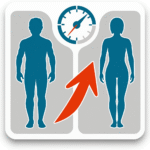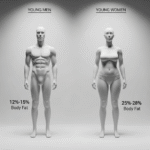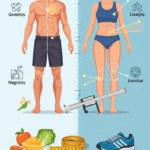Body Composition Calculator insights await! Understand health metrics, gender impacts, and actionable tips to elevate your fitness goals effectively.
Body Composition Calculator
Table of Contents
Explore the significance of body composition and its impact on health and fitness. Learn how to use body composition calculators to evaluate fat and lean mass, understand key metrics affecting your health, and discover the importance of gender differences in body composition analysis. This guide also addresses common misconceptions and offers practical applications to enhance your fitness journey. Achieve your health goals with a comprehensive approach to body composition that emphasizes nutrition, exercise, and lifestyle choices.

Introduction to Body Composition
Body composition refers to the distinct elements that make up an individual’s body, including fat mass, lean body mass, water, and mineral content. Unlike simple weight measurements, body composition offers a deeper insight into an individual’s body health and fitness level. Understanding body composition is crucial because it distinguishes between fat and non-fat components of the body, providing a clearer picture of one’s overall health.
Weight alone can be misleading, as it does not account for the distribution of fat and muscle. For instance, two individuals may weigh the same, but if one has a higher muscle mass and lower body fat percentage, they could be in a significantly healthier state. This highlights the importance of evaluating body composition, as overall health can be adversely affected by excess body fat, regardless of a person’s weight.
Fat mass, which includes essential fat necessary for bodily functions, and stored fat, can significantly influence individual health and performance. Excess body fat, particularly visceral fat surrounding internal organs, is associated with increased risks of chronic conditions such as obesity, diabetes, and heart disease. On the other hand, lean body mass, which consists of muscles, bones, and organs, plays a vital role in metabolic processes and physical capabilities.
Acknowledging the influence of body composition on athletic performance is particularly significant for athletes and individuals engaged in physical training. The proportion of body fat to lean mass can impact strength, endurance, and overall athletic capabilities. Therefore, utilizing body composition calculators can serve as a beneficial tool for monitoring and managing one’s fitness journey. By focusing on body composition rather than just weight, individuals can better assess their health and pursue tailored strategies for improvement.
The Importance of Gender in Body Composition Calculators

Body composition calculators play a crucial role in providing insights into an individual’s health and fitness by analyzing the ratios of fat to lean mass in the body. However, the accuracy and reliability of these calculations are significantly influenced by gender. This variance arises from fundamental physiological differences between males and females, which directly impact body fat distribution and metabolic rates.
Males typically possess a higher proportion of muscle mass and lower levels of body fat compared to females. This discrepancy is largely attributed to hormonal differences; for instance, testosterone promotes muscle growth and fat reduction, while estrogen contributes to a higher fat percentage in females, particularly in regions such as the hips and thighs. Consequently, body composition calculators that account for gender variations utilize distinct algorithms to better reflect these underlying biological factors.
Moreover, metabolic rates differ between genders, with males generally experiencing a higher basal metabolic rate (BMR). This rate determines the energy expenditure at rest and prominently affects the overall body composition. As a result, body composition calculators often incorporate BMR metrics that vary according to gender, which further enhances their precision in assessing an individual’s health status. Calculators may also take into consideration other attributes such as age and activity level, but gender remains a fundamental factor that modifies the algorithms to yield more accurate results.
In summary, understanding the importance of gender in body composition calculations is essential for interpreting the results and utilizing them effectively in health and fitness plans. By acknowledging the physiological differences that exist between males and females, users can better appreciate how these calculators provide tailored assessments, leading to more meaningful health outcomes.
Key Metrics for Calculating Body Composition
Understanding body composition involves evaluating several critical metrics that provide insight into an individual’s physical health. The most commonly utilized metrics include age, weight in kilograms, height in centimeters, and various circumferences of the body, such as neck, waist, and hip circumference. Each of these measurements plays a significant role in determining one’s body composition and can guide health assessments.
Age is an essential factor because it influences metabolic rate and body composition changes over time. Younger individuals generally have a higher metabolic rate, which affects how their body utilizes energy and stores fat. As people age, fluctuations in body fat and muscle mass become more pronounced, making age a vital component in any body composition calculation.
Weight, measured in kilograms, is another fundamental metric. It serves as a primary indicator of overall mass but does not differentiate between fat and lean body mass. Thus, it must be interpreted alongside other measurements for an accurate assessment. Height, measured in centimeters, complements weight, as it helps establish body mass index (BMI) and provide insights into whether a person is underweight, normal weight, overweight, or obese.
In addition to weight and height, neck circumference is critical for evaluating fat distribution patterns, especially in identifying potential health risks associated with obesity. Waist circumference is particularly important, as it can indicate visceral fat, which is linked to cardiovascular diseases. Similarly, hip circumference can provide insight into body shape and fat distribution, offering a broader perspective on health risks.
Understanding these key metrics allows individuals and health professionals to paint a more comprehensive picture of body composition, assess health risks, and formulate strategies for better health outcomes.
How to Use a Body Composition Calculator
Using a body composition calculator is a straightforward process that can provide valuable insights into your physical health. To begin, gather the necessary personal data and physical measurements. The first step involves entering your gender and age, as these factors play a significant role in determining body composition. Typically, calculators will prompt you to select your gender from predefined options, usually male or female, and input your age.
The next step requires you to measure and input your height and weight. It is advisable to use a scale for your weight measurement and a stadiometer or wall-mounted measure for height. Ensure that these measurements are accurate, as they are crucial for the calculation of body fat percentage and other metrics. In addition to height and weight, many calculators also ask for circumference values. Commonly measured circumferences include waist, hips, and neck, each of which provides more context about fat distribution in the body.
Once you have gathered this information, input all values into the calculator as instructed. The calculator will use these data points to generate results, which typically include body fat percentage and lean body mass. Some calculators may provide further insights, such as recommendations for goal weight or healthy habits based on your current body composition.
After receiving your results, it is essential to interpret them correctly. Understand that the figures presented may vary depending on the methodology used by the calculator. Many factors can influence body composition, including muscle mass and distribution. Therefore, while the calculator provides a useful estimate, it should not be the sole determinant of one’s health. It is always advisable to consult with healthcare professionals for a more comprehensive analysis.

Understanding the Results: What Does Your Composition Say?
Interpreting the results of a body composition calculator is crucial for understanding your overall health and fitness. One of the primary metrics obtained is the body fat percentage, which indicates the proportion of fat in relation to your total body weight. A healthy body fat percentage varies based on age, sex, and activity level, but generally, a range of 10-20% for men and 18-28% for women is considered normal. Values below or above these ranges may signal a need for improvement in your fitness or dietary regimen.
Another important metric derived from body composition calculators is fat-free mass (FFM). This represents the total weight of all your body’s non-fat components, including muscle, bone, and water. FFM is critical in assessing your body’s metabolic capabilities; a higher FFM is often correlated with better physical performance and metabolic health. Understanding your FFM can help in tracking muscle gain and fat loss, providing a holistic view of your fitness journey.
Additionally, alongside body fat percentage and fat-free mass, other measurements such as waist-to-hip ratio and body mass index (BMI) can offer further insight into your health status. For instance, a high waist-to-hip ratio may indicate a risk for cardiovascular diseases, regardless of overall body weight. Therefore, it is essential to look at the comprehensive picture rather than focusing solely on one metric.
In conclusion, the results from a body composition calculator can guide you in evaluating your health and fitness levels. By understanding your body fat percentage, fat-free mass, and other metrics, you can take informed steps towards improving your body composition and achieving your health goals. Emphasizing a balanced approach to diet and exercise is crucial for optimizing your results and maintaining a healthy body composition.
Factors Influencing Body Composition
Body composition refers to the proportion of fat, muscle, bone, and other tissues in the body. A myriad of factors can influence an individual’s body composition, significantly impacting overall health and wellness. Understanding these influences is essential for anyone seeking to interpret body composition accurately and set realistic health goals.
Genetics plays a critical role in determining individual body composition. Genetic predispositions can influence fat distribution, muscle mass, and metabolic rates. While one person may naturally maintain a lower body fat percentage, another may find it more challenging due to hereditary factors. Thus, genetics set the stage for potential body composition outcomes, providing a framework within which individuals can work.
Diet also significantly affects body composition. The types and quantities of food consumed directly impact fat stores and muscle mass. A balanced diet rich in proteins, healthy fats, and carbohydrates supports muscle development while controlling body fat levels. Conversely, excessive caloric intake or poor dietary choices can lead to an undesirable increase in body fat. Nutritional habits, therefore, must be carefully monitored to achieve optimal body composition results.
Physical activity trends contribute substantially to alterations in body composition. Regular exercise fosters muscle growth and fat loss, enhancing overall body composition. Strength training, in particular, is instrumental in increasing lean muscle mass, which can improve metabolic efficiency and contribute to fat loss. Additionally, engaging in cardiovascular exercise augments caloric expenditure, thereby assisting in controlling body fat.
Lifestyle choices, such as sleep quality and stress management, also play critical roles in shaping body composition. Inadequate sleep can disrupt hormonal balances that regulate hunger and metabolism, leading to weight gain or difficulty losing weight. Stress can similarly affect body weight by influencing eating behaviors and hormone secretion. Consequently, adopting a holistic approach that encompasses dietary, physical, and lifestyle choices is crucial for achieving and maintaining ideal body composition.
Common Misconceptions About Body Composition
Body composition calculators are increasingly popular tools in fitness and health domains, yet several misconceptions persist regarding their accuracy and implications. One common myth is that these calculators only provide a definitive measure of health or fitness. In reality, body composition is a multifaceted construct that includes fat mass, muscle mass, and overall distribution. Relying solely on numbers from a calculator can lead to misleading interpretations about one’s health status.
Another prevalent misconception is the belief that weight loss equates directly to improved body composition. Many individuals pursue weight loss strictly through caloric restriction without considering the type of weight being lost. For instance, significant caloric deficits can result not only in fat loss but also in unwanted muscle loss. This could ultimately impair metabolic health and diminish physical performance.
Furthermore, the idea that certain body types are inherently superior is misleading. Social media and popular culture often portray certain physiques as ideals which can distort an individual’s perception of healthy body composition. It is important to recognize that each person’s body is unique, and factors such as genetics, age, and lifestyle significantly influence healthy body composition. The focus should be on achieving a balanced distribution of muscle and body fat rather than adhering to external standards of perceived perfection.
Contrary to popular belief, body composition should not only be assessed through weight and simple measurements. Advanced techniques, such as bioelectrical impedance analysis and dual-energy X-ray absorptiometry, can provide more nuanced insights. However, these may not always be accessible or applicable. Consequently, individuals should take a holistic approach to body composition, using calculators as one of many tools—but not the sole determinant—of their health and fitness journey.

Practical Applications of Body Composition Analysis
Body composition analysis plays a pivotal role in understanding individual health and fitness levels. By providing detailed insights into the proportion of fat, muscle, and water in the body, these assessments offer valuable information for individuals, trainers, and health professionals alike. One of the primary applications is in fitness planning, where trainers utilize body composition data to tailor exercise regimens. For instance, an individual with a higher body fat percentage may require a different workout approach than someone with more muscle. This ensures that the training program is aligned with personal goals, whether that be weight loss, muscle gain, or improved athletic performance.
Weight loss programs also significantly benefit from body composition analysis. Rather than solely focusing on scale weight, which can be misleading, individuals are encouraged to track changes in body fat and lean mass. This approach fosters a healthier relationship with weight management. For example, a case study involving a client who aimed to reduce body fat demonstrated that although weight fluctuated during the program, the reduction in body fat percentage showcased substantial progress, leading to improved confidence and motivation.
Moreover, health monitoring is another crucial application of body composition analysis. Health professionals can utilize this data to identify potential health risks, such as obesity-related conditions. A healthcare provider may find that elevated body fat levels in a patient could necessitate lifestyle interventions like nutrition counseling or increased physical activity. Regular assessments facilitate ongoing monitoring, enabling timely adjustments to health strategies. In a real-life scenario, a fitness center conducted regular body composition assessments for its members, leading to enhanced engagement and accountability for health outcomes. This demonstrates how leveraging body composition data creates pathways towards effective health interventions and sustainable lifestyle changes.
Conclusion
In summary, understanding body composition is essential for anyone looking to improve their health and fitness. Body composition calculators serve as valuable tools that offer insights into the proportions of fat, muscle, and other components of the body. These calculators can help individuals set realistic health goals, track progress, and make informed decisions about their exercise and nutrition strategies. By analyzing body composition, one can gain a clearer picture of overall health and wellness, moving beyond weight alone.
As we explored in this guide, there are various methods to measure body composition, including bioelectrical impedance, skinfold measurements, and dual-energy X-ray absorptiometry (DEXA). Each method offers unique advantages and limitations, which should be considered when choosing the most suitable option for individual needs. Furthermore, it is important to interpret the results within the context of personal health objectives and lifestyle factors.
To maximize the benefits of using body composition calculators, individuals are encouraged to adopt a holistic approach to health that incorporates balanced nutrition, regular physical activity, and adequate rest. Combining the insights gained from body composition analysis with ongoing monitoring can lead to significant improvements in overall health outcomes.
For those interested in deepening their understanding of body composition and health, numerous resources are available, including scientific literature, online courses, and expert consultations. Engaging with relevant studies or seeking guidance from fitness professionals can provide further clarity and support in the journey toward optimal health. Embracing body composition calculators as part of a comprehensive health strategy can empower individuals to achieve their fitness objectives more effectively.









